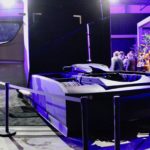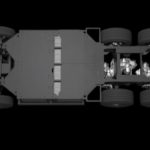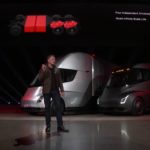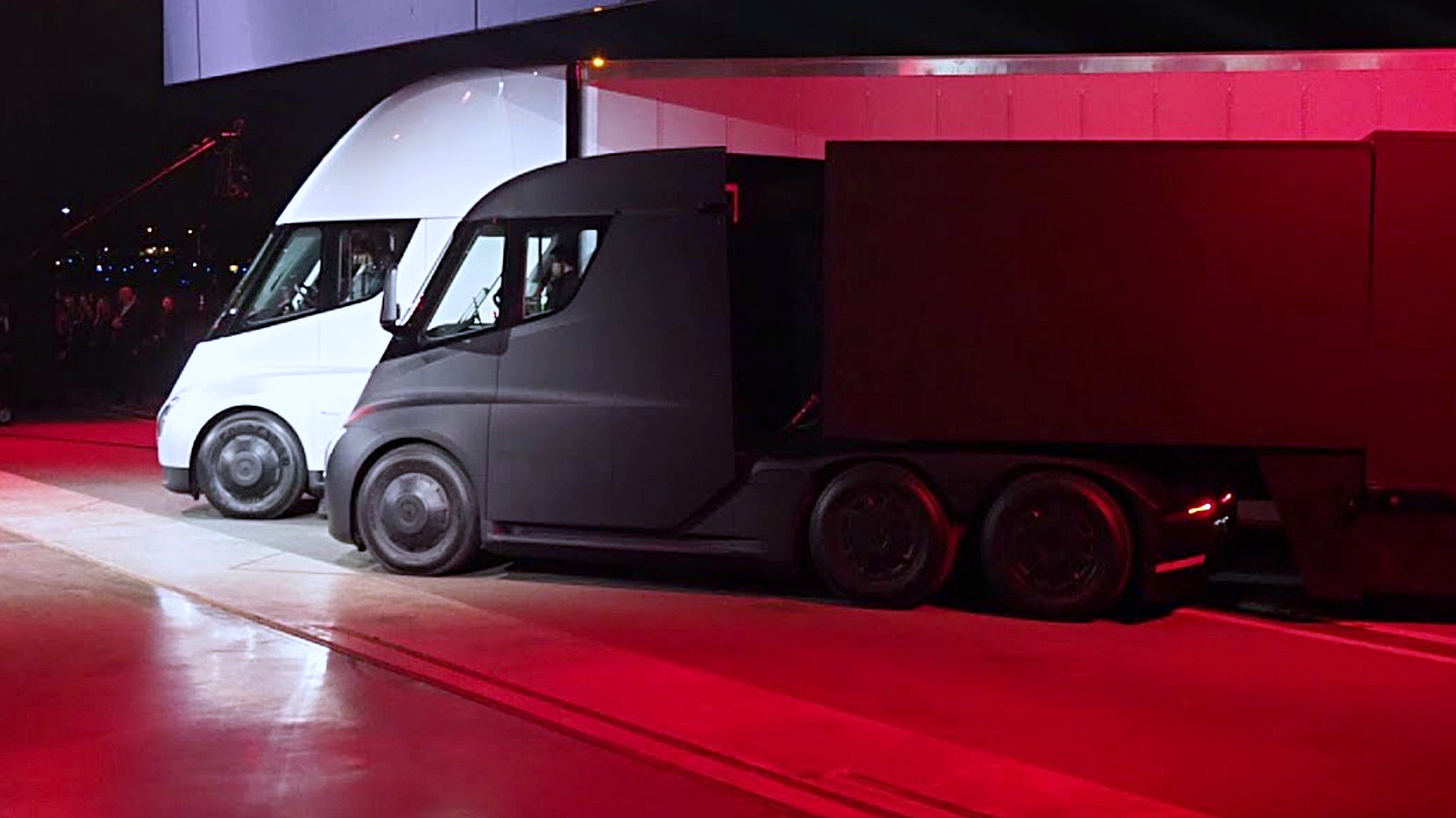

News
Tesla Semi truck’s battery pack and overall weight explored
The big question on everyone’s mind–at least on the minds of those who understand the freight transportation industry–is how much the Tesla Semi might weigh. If Tesla’s all-electric semi truck is to be competitive at all, it must be capable of carrying the same loads as current-use semi-trucks in the Class 8 field do.
A big point of contention from nay-sayers and those in the trucking industry who understand logistics was the lack of announcement of the Tesla Semi’s actual weight. Plenty of press was given to the much-touted “80,000-pound capacity” number bandied around by CEO Elon Musk during the truck’s unveiling late last year. That number, however, refers only to the gross vehicle weight (GVW) of the Tesla Semi and is, in fact, exactly the same number used by every Class 8 truck on the road. They’re called Class 8s, in fact, because the 8 refers to that 80,000-pound total vehicle capacity.
What wasn’t given by Tesla was the gross vehicle tare weight (GVTW) of the Semi. This is a far more important number. Where the GVW gives the total capacity of the truck in terms of how much its freight plus the truck itself can weigh, the GVTW gives just the weight of the truck, sans trailer and freight. This number tells logistics experts how much actual freight and trailer the truck can haul legally.
For example, a typical “day cab” configuration 18-wheeler with a diesel engine weighs roughly 32,000 pounds with a relatively lightweight box trailer attached and full fuel tanks. That leaves about 48,000 pounds of freight capacity for the truck. That’s important because, although the truck won’t be loaded to capacity every time, it will be expected to be capable of carrying up to about that weight. Most big rigs on the road are capable of hauling 44,000 or more pounds worth of freight, depending on configuration and trailer type.
Having experience with driving commercial trucks in the past, once hauling a refrigerated trailer that had a freight capacity of 44,500 pounds, I learned that some industries count on freight capacity as part of their logistics costs and will literally fill a truck to its maximum in order to minimize those costs.
In logistics, weight and total freight capacity are highly important metrics in the overall scheme.
What We Know
Thinking about that, then, let’s look at what we know of the Tesla Semi and its potential weight. We know that the truck uses four independent electric motors that are derived from the Model 3, that it has an energy consumption of less than 2 kWh per mile, and that it can be charged to up to 400 miles in about half an hour. We also know that Elon promised 300 to 500 miles of range in total. On that latter point, it’s pretty clear that a “lower range, cheaper option” will be offered as has been done with most of Tesla’s vehicles to-date. So we can assume a 300-mile version and a 500-mile version will be forthcoming for the Semi.
We also know that the Tesla Semi had eight ports in its charging plug array. We saw this at the unveil in some close-up photos.
It’s clear to us that even if the Tesla Semi isn’t to become a big player in the trucking industry, the idea behind it will change things forever.
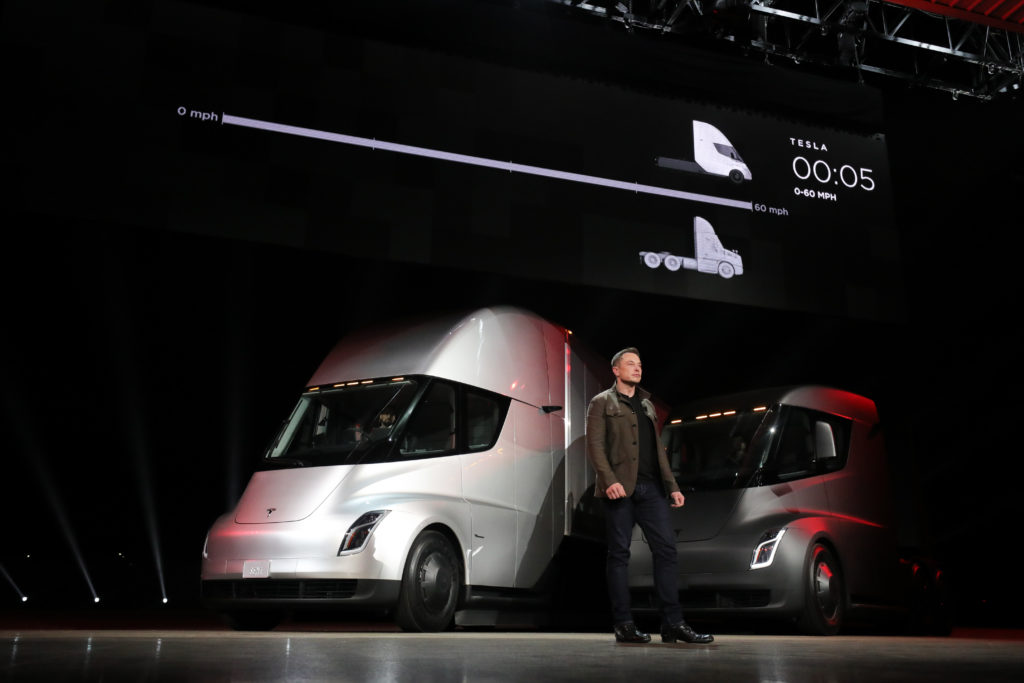
What We Don’t Know
What we don’t know is whether Musk and Co have something up their sleeves for the batteries. Much of the speculation regarding the Tesla Semi has been in regards to Tesla Semi’s massive battery pack.
In actuality, having a huge battery breakthrough on a vehicle like the Tesla Semi would not necessarily be a good thing for business. If there is a huge breakthrough, then all bets are off and most of our speculation in this article is moot. That would, however, mean that the sales potential of the Semi would be far lower than it would be otherwise because one thing that logistics companies and fleet managers aren’t interested in are flashy new, breakthrough, and (most importantly) untested, unproven technologies.
To a fleet manager, those phrases mean “breaks often, expensive to fix” and the potential positives will be ignored because of that. No one who wants to keep a job as a fleet manager or logistics purchaser will gamble on something unproven. Like new battery technology for a truck whose primary cost will be in its batteries. Likewise, unless there is a clear benefit in some terms other than pure business (like marketing or potential tax breaks), no board of directors will risk shareholder wrath on new tech either.
Close-up look at Tesla Semi’s drivetrain from underneath
We can say, as a side note, that most of the orders that have been placed for the Tesla Semi thus far are from corporations and companies who are doing business in areas where the marketing bonanza and potential tax incentives for laying down those relatively low-cost deposits are immense. Most of the companies involved have already invested heavily (and very publicly) in alternative fuel options outside of Tesla over the past few years. We also note the timing of both the Tesla Semi’s announcement (and order-taking) and the before-2018 rush by potential customers to put in deposits.
We reiterate that our not knowing if Tesla has some kind of big battery breakthrough announcement is a big “if” in our analysis here.
What People Smarter Than Us Have Said
Some people who know more than we do about things like math and engineering science have crunched the numbers on the Tesla Semi’s battery potentials. Over at Engineering.com, John Ewbank broke the results down into layman format. Here’s the gist.
If the Tesla Semi uses 2 kWh to travel a mile, then a 500-mile range means 1,000 kWh of power. That is not the actual size of the battery, though, as the charging requirement would preclude a huge pack.
In order to get 400 miles in thirty minutes of charging, Ewbank notes, the charger would have to be 1.6MW to achieve the 800kWh of promised charge in only 30 minutes. Charging at that rate is not possible because the result would be arching in the pack, which would surely be akin to the next Boring Company Flamethrower meme when Semi trucks begin to explode in flames during charging as a regular event. So the charging has to be split up.
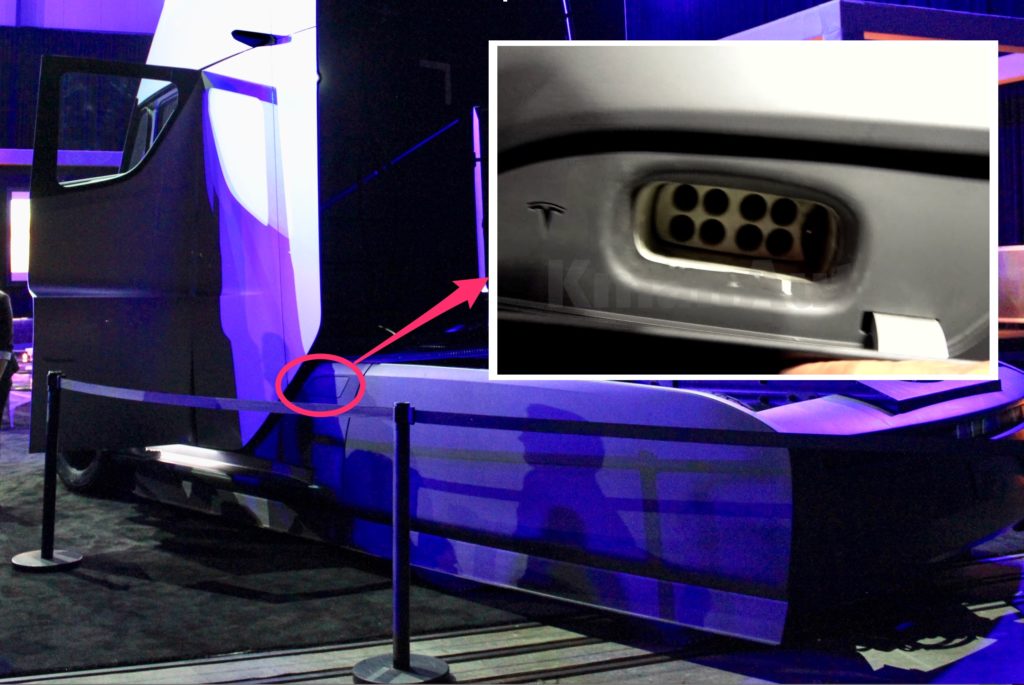
Tesla Semi Megacharger port could support 1 MW of power.
The answer is simple, of course, and may explain the strange layout of the eight-port charging hub shown on the Semi at its unveil: there are four battery packs.
Instead of one big pack, four smaller packs (one for each motor, even) are used and are thus charging separately from one another, but simultaneously. Based on Tesla Semi’s Megacharger port configuration, this would likely mean that four of them are positive sides and the other four are grounds. Allowing for a single, huge wire to be plugged into each. The controls for the charging system interface may be plugged in separately (perhaps the oval-shaped black thing to the side?).
What This Adds Up To
We add up that bit of information plus what we know about the truck and get an estimated weight. Using the current weight of a Tesla Model S battery pack at 540kg per 90 kWh, we can do some simple math to estimate the Semi’s batteries would weigh about 6,000 kg. We aren’t sure about the new battery weights for the upcoming battery updates, but we can assume a 10-15 percent reduction from several factors (storage density, improvements in chemistry, packaging lightening) without being too aggressive or overly optimistic. Going with the fifteen percent reduction, that 6,000 kg drops to 5,100 kg. That’s about 11,244 pounds.
A conventional tractor, as we’ve said, has a tare weight of around 32,000 pounds when fully fueled and with a lightweight box trailer in place. Remove the trailer and the truck itself is about 22,500 pounds. It’s difficult to then go to just the weight of the powertrain components and fuel, but they’re considerably less than 11,000 pounds in all.
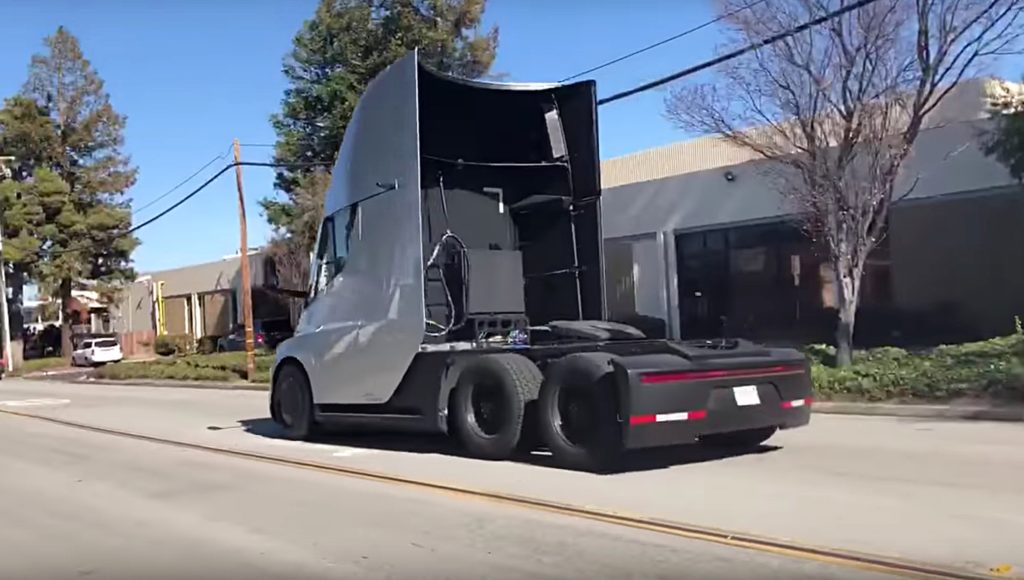
Tesla Semi spotted doing a tire-shredding acceleration run down in the wild
Looking at the shipping weight for a crated engine and transmission for a Class 8 truck, we can see that they weigh about 8,000 pounds on average. Add in fuel and other components and another 1,500 pounds (at most) are put on the truck. We then assume that the rest of the truck (framing, braking systems, air compressor, etc) are about the same for the Tesla Semi in order for it to meet Class 8 standards. So we call those a wash.
That means that the Semi, under our estimates, is roughly two tons heavier than would be a standard day cab big truck in the Class 8 category. This means the Semi would be that much less capable in terms of freight hauling that’s offset by its unprecedented all-electric performance. That amount, however, is probably not enough to stop the primary buyers of a day cab truck like this from balking at a purchase. The weight difference alone would be repaid in potential fuel savings, tax incentives, green marketing, and maintenance costs.
The trouble will come with cost differences. If the ROI is not there, most logistics buyers won’t write any purchase orders. But at least we can say that as far as we can tell, the weight differences of the Tesla Semi alone aren’t going to be a huge bar against entry into the trucking industry.
Elon Musk
Tesla Supercharger Diner food menu gets a sneak peek as construction closes out
What are you ordering at the Tesla Diner?

The Tesla Supercharger Diner in Los Angeles is nearing completion as construction appears to be winding down significantly. However, the more minor details, such as what the company will serve at its 50s-style diner for food, are starting to be revealed.
Tesla’s Supercharger Diner is set to open soon, seven years after CEO Elon Musk first drafted the idea in a post on X in 2018. Musk has largely come through on most of what he envisioned for the project: the diner, the massive movie screens, and the intended vibe are all present, thanks to the aerial and ground footage shared on social media.
We already know the Diner will be open 24/7, based on decals placed on the front door of the restaurant that were shared earlier this week. We assume that Tesla Optimus will come into play for these long and uninterrupted hours.
The Tesla Diner is basically finished—here’s what it looks like
As far as the food, Tesla does have an email also printed on the front door of the Diner, but we did not receive any response back (yet) about what cuisine it will be offering. We figured it would be nothing fancy and it would be typical diner staples: burgers, fries, wings, milkshakes, etc.
According to pictures taken by @Tesla_lighting_, which were shared by Not a Tesla App, the food will be just that: quick and affordable meals that diners do well. It’s nothing crazy, just typical staples you’d find at any diner, just with a Tesla twist:
Tesla Diner food:
• Burgers
• Fries
• Chicken Wings
• Hot Dogs
• Hand-spun milkshakes
• And more https://t.co/kzFf20YZQq pic.twitter.com/aRv02TzouY— Sawyer Merritt (@SawyerMerritt) July 17, 2025
As the food menu is finalized, we will be sure to share any details Tesla provides, including a full list of what will be served and its prices.
Additionally, the entire property appears to be nearing its final construction stages, and it seems it may even be nearing completion. The movie screens are already up and showing videos of things like SpaceX launches.
There are many cars already using the Superchargers at the restaurant, and employees inside the facility look to be putting the finishing touches on the interior.
🚨 Boots on the ground at the Tesla Diner:
— TESLARATI (@Teslarati) July 17, 2025
It’s almost reminiscent of a Tesla version of a Buc-ee’s, a southern staple convenience store that offers much more than a traditional gas station. Of course, Tesla’s version is futuristic and more catered to the company’s image, but the idea is the same.
It’s a one-stop shop for anything you’d need to recharge as a Tesla owner. Los Angeles building permits have not yet revealed the date for the restaurant’s initial operation, but Tesla may have its eye on a target date that will likely be announced during next week’s Earnings Call.
News
Tesla’s longer Model Y did not scale back requests for this vehicle type from fans
Tesla fans are happy with the new Model Y, but they’re still vocal about the need for something else.

Tesla launched a slightly longer version of the Model Y all-electric crossover in China, and with it being extremely likely that the vehicle will make its way to other markets, including the United States, fans are still looking for something more.
The new Model Y L in China boasts a slightly larger wheelbase than its original version, giving slightly more interior room with a sixth seat, thanks to a third row.
Tesla exec hints at useful and potentially killer Model Y L feature
Tesla has said throughout the past year that it would focus on developing its affordable, compact models, which were set to begin production in the first half of the year. The company has not indicated whether it met that timeline or not, but many are hoping to see unveilings of those designs potentially during the Q3 earnings call.
However, the modifications to the Model Y, which have not yet been officially announced for any markets outside of China, still don’t seem to be what owners and fans are looking forward to. Instead, they are hoping for something larger.
A few months ago, I reported on the overall consensus within the Tesla community that the company needs a full-size SUV, minivan, or even a cargo van that would be ideal for camping or business use.
Tesla is missing one type of vehicle in its lineup and fans want it fast
That mentality still seems very present amongst fans and owners, who state that a full-size SUV with enough seating for a larger family, more capability in terms of cargo space for camping or business operation, and something to compete with gas cars like the Chevrolet Tahoe, Ford Expedition, or electric ones like the Volkswagen ID.BUZZ.
We asked the question on X, and Tesla fans were nearly unanimously in support of a larger SUV or minivan-type vehicle for the company’s lineup:
🚨 More and more people are *still* saying that, despite this new, longer Model Y, Tesla still needs a true three-row SUV
Do you agree? https://t.co/QmbRDcCE08 pic.twitter.com/p6m5zB4sDZ
— TESLARATI (@Teslarati) July 16, 2025
Here’s what some of the respondents said:
100% agree, we need a larger vehicle.
Our model Y is quickly getting too small for our family of 5 as the kids grow. A slightly longer Y with an extra seat is nice but it’s not enough if you’re looking to take it on road trips/vacations/ kids sports gear etc.
Unfortunately we…
— Anthony Hunter (@_LiarsDice_) July 17, 2025
Had to buy a Kia Carnival Hybrid because Tesla doesn’t have a true 3 row vehicle with proper space and respectable range. pic.twitter.com/pzwFyHU8Gi
— Neil, like the astronaut (@Neileeyo) July 17, 2025
Agreed! I’m not sure who created this but I liked it enough to save it. pic.twitter.com/Sof5nMehjS
— 🦉Wise Words of Wisdom – Inspirational Quotes (IQ) (@WiseWordsIQ) July 16, 2025
Tesla is certainly aware that many of its owners would like the company to develop something larger that competes with the large SUVs on the market.
However, it has not stated that anything like that is in the current plans for future vehicles, as it has made a concerted effort to develop Robotaxi alongside the affordable, compact models that it claims are in development.
It has already unveiled the Robovan, a people-mover that can seat up to 20 passengers in a lounge-like interior.
The Robovan will be completely driverless, so it’s unlikely we will see it before the release of a fully autonomous Full Self-Driving suite from Tesla.
Energy
Tesla launches first Virtual Power Plant in UK – get paid to use solar
Tesla has launched its first-ever Virtual Power Plant program in the United Kingdom.

Tesla has launched its first-ever Virtual Power Plant program in the United Kingdom. This feature enables users of solar panels and energy storage systems to sell their excess energy back to the grid.
Tesla is utilizing Octopus Energy, a British renewable energy company that operates in multiple markets, including the UK, France, Germany, Italy, Spain, Australia, Japan, New Zealand, and the United States, as the provider for the VPP launch in the region.
The company states that those who enroll in the program can earn up to £300 per month.
Tesla has operated several VPP programs worldwide, most notably in California, Texas, Connecticut, and the U.S. territory of Puerto Rico. This is not the first time Tesla has operated a VPP outside the United States, as there are programs in Australia, Japan, and New Zealand.
This is its first in the UK:
Our first VPP in the UK
You can get paid to share your energy – store excess energy in your Powerwall & sell it back to the grid
You’re making £££ and the community is powered by clean energy
Win-win pic.twitter.com/evhMtJpgy1
— Tesla UK (@tesla_uk) July 17, 2025
Tesla is not the only company that is working with Octopus Energy in the UK for the VPP, as it joins SolarEdge, GivEnergy, and Enphase as other companies that utilize the Octopus platform for their project operations.
It has been six years since Tesla launched its first VPP, as it started its first in Australia back in 2019. In 2024, Tesla paid out over $10 million to those participating in the program.
Participating in the VPP program that Tesla offers not only provides enrolled individuals with the opportunity to earn money, but it also contributes to grid stabilization by supporting local energy grids.
-

 Elon Musk1 day ago
Elon Musk1 day agoWaymo responds to Tesla’s Robotaxi expansion in Austin with bold statement
-

 News1 day ago
News1 day agoTesla exec hints at useful and potentially killer Model Y L feature
-

 Elon Musk2 days ago
Elon Musk2 days agoElon Musk reveals SpaceX’s target for Starship’s 10th launch
-

 Elon Musk3 days ago
Elon Musk3 days agoTesla ups Robotaxi fare price to another comical figure with service area expansion
-

 News1 day ago
News1 day agoTesla’s longer Model Y did not scale back requests for this vehicle type from fans
-

 News1 day ago
News1 day ago“Worthy of respect:” Six-seat Model Y L acknowledged by Tesla China’s biggest rivals
-

 News2 days ago
News2 days agoFirst glimpse of Tesla Model Y with six seats and extended wheelbase
-

 Elon Musk2 days ago
Elon Musk2 days agoElon Musk confirms Tesla is already rolling out a new feature for in-car Grok

